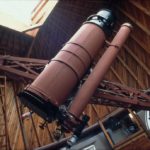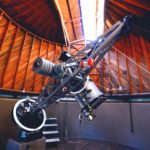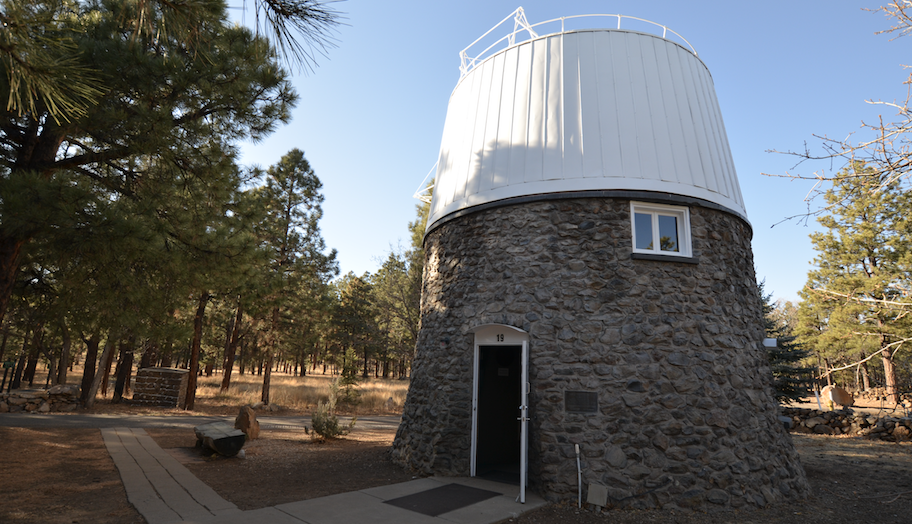
Photo: The Pluto Discovery Dome | Sarah Gilbert
Construction on the building known today as the Pluto Discovery Dome was completed in September of 1928, 11 years and 10 months after the death of observatory founder and Planet X seeker Percival Lowell. Though Percival himself would not live to see his Planet X found, this unassuming, two-story telescope dome made of local basalt rock is where the decades-long quest would finally come to an end.
A New Beginning
The fevered search for Planet X was placed on hold for nearly a decade after Percival’s passing in November of 1916, due large in part to a tense legal battle between the observatory and his widow, Constance Lowell, concerning the contents of his will. This, coupled with the onset of World War 1, brought the observatory to the brink of financial ruin. By 1927, however, the role of sole trustee had been passed onto Roger Lowell Putnam, Percival’s nephew. Determined to bring the observatory back to prominence after a period of financial hardship and low morale, Roger resurrected his uncle’s tireless search for the 9th planet in our solar system. To accomplish this, he enlisted the help of then-director V.M. Slipher. While Slipher planned out the construction of a telescope dome, Roger went about searching for a telescope to inhabit it.
Building a Piece of History
For the location of the telescope dome, Slipher chose a hill located 100 yards west of the observatory’s administration building (now known as the Slipher Building), on land leased from the U.S. Forest Service. This land, as well as the acres behind it, would later become observatory property. Construction on the dome began in early 1928, lead by observatory instrument maker Stanley Sykes. Stanley used a design very similar to the one that his brother Godfrey had used to construct the Clark Telescope Dome decades earlier, employing the same inverted bucket shape for the dome’s roof. The most significant difference in the new design was the addition of a second story, where the telescope itself would be housed and operated. The walls were constructed with cement and Malpais rock1 collected from the observatory grounds.
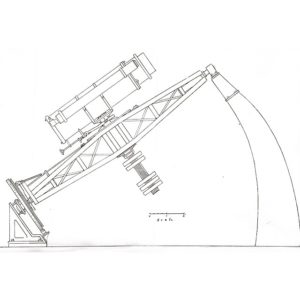
An original sketch of the 13″ Lawrence Lowell Telescope.
Meanwhile, Roger searched for a telescope manufacturer to make use of three partially figured, 13 inch-diameter glass discs acquired from the estate of recently-deceased optician Joel Metcalf, who had been working on the discs at the time of his death. After looking into several options, Roger chose Robert Lundin of Alvin Clark & Sons, whose father had assisted in the construction of the Clark, for the task of assembling a 40-inch reflector to be used in the renewed search for Planet X. The telescope would be an astrograph, meaning that it would be designed solely for the purpose of taking photos of celestial objects. The scope was officially named the Lawrence Lowell Telescope, after Percival’s brother, Abbott Lawrence Lowell.
[vcex_divider color=”#dddddd” width=”100%” height=”1px” margin_top=”20″ margin_bottom=”20″]
1 A type of basalt found in the Southwestern U.S., Mexico, Spain, and other Spanish-speaking regions of the world. Many of the buildings on our Mars Hill campus and around the town of Flagstaff are constructed with it!
Not in Kansas Anymore
While construction on the telescope and its dome progressed, Slipher received a letter from Clyde Tombaugh, a 23-year-old farm boy from Kansas asking for a professional opinion on the sketches he had made while observing planets through his homemade telescope. Impressed, Slipher exchanged several letters with Tombaugh before offering him a job at the observatory on a trial basis. Slipher was somewhat vague about what Tombaugh’s responsibilities would include, alluding to photography and janitorial work, but stated that he might be offered a more permanent position at the observatory if he could prove his usefulness. As history would show, Tombaugh would go on to prove his worth and then some. He accepted Slipher’s offer and arrived in Flagstaff on January 15, 1929, two weeks after receiving the letter.
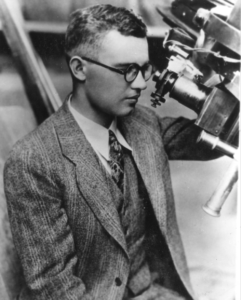
Clyde Tombaugh at the guide scope for the 13″ astrograph.
The astrograph and its dome were completed the following month of the same year, and the first exposure was taken on February 16. It was in this dome that Clyde would spend many cold, tedious nights alone, guiding the telescope in search of the elusive Planet X. On one of these such nights, Clyde found himself suddenly feeling very warm and sleepy in the otherwise freezing telescope dome. Had he not recognized this as a sign of hypothermia setting in, he might have frozen to death. On another night, he was trapped inside the dome for several hours while a hungry mountain lion prowled outside. However, these hardships would pay off in a big way on February 18, 1930—exactly 1 year and 34 days following the date that Tombaugh first began his employment at Lowell. He discovered Planet X, which he would later name Pluto, while comparing two exposures he had taken with the astrograph.
Today, the Pluto Discovery Dome stands as a monument to an unforgettable moment in astronomy history. Though the Lawrence Lowell Telescope is no longer used for observation, it was refurbished in 2017 along with the dome to ensure that its legacy can be preserved for generations to come.
- The Pluto Discovery Telescope before its restoration in 2017.
- The Pluto Telescope after its restoration.
New Additions
If you look closely at the telescope, you’ll notice a red boxing glove attached to its metal arm. Ralph Nye, who maintained the Lowell telescopes in the 1990’s, was working on the telescope when he hit his head on the end of the arm. This made him see the wrong kind of stars, so he added the glove as a cushion to prevent it from happening again.
Hidden in a cabinet beneath the motor that drives dome movement is a time capsule. It contains Pluto memorabilia including scientific publications, a hat Clyde Tombaugh wore while observing, and a pencil used by scientists during the 2015 New Horizons Mission. Created in collaboration with New Horizons Principal Investigator Alan Stern, the capsule is to remain sealed until an orbiter is sent to explore the surface of Pluto.
Check out Secrets of Lowell on Tiktok!
@lowellobservatoryWhat’s in that time capsule? And how did that boxing glove get up there? 🤔 The observatory is full of mysteries, but our blog may have some answers.♬ Moonlight Serenade – Glenn Miller
